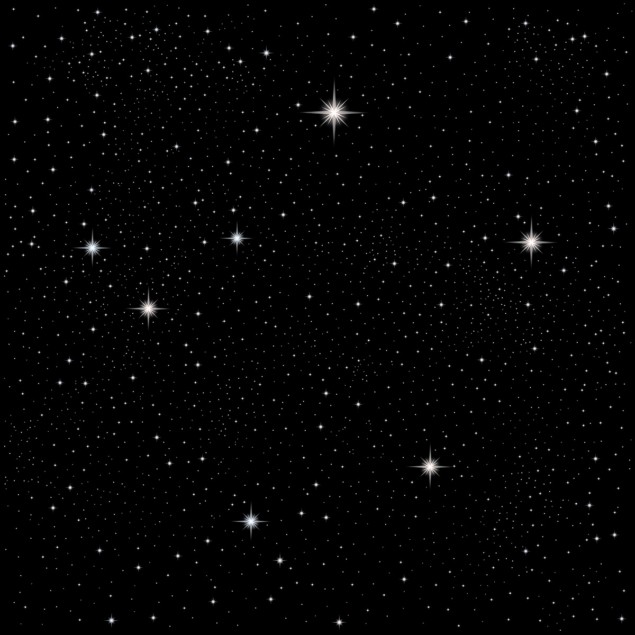Quantum error correction could help astronomers image stars
10 Jan 2023 Maria Violaris
Quantum error correction can protect fragile captured starlight from being degraded by unwanted interactions with its environment. (Courtesy: iStock/angelinast)
Space is not a studio: when studying stars, astronomers have no control over the objects they are trying to image. Instead, they rely on improvements to telescopes and analysis techniques to create higher-resolution images from whatever light they receive, however faint or noisy it may be. Now, a team of scientists has proposed a way of using quantum error correction to combat noise in the starlight captured by telescopes. According to the team, even the simplest error-correction protocols run on near-term quantum devices could offer a significant advantage for astronomical imaging.
Imaging resolution is typically limited by diffraction. Quantum sensing techniques can surpass this limit if the imaged object can be manipulated or illuminated, but this is not possible in astronomy. Researchers at Macquarie University in Australia and the National University of Singapore (NUS) have, however, found a workaround: they showed that quantum error correction can protect fragile captured starlight from being degraded by unwanted interactions with its environment.
Alice and Bob rewrite the stars
The idea behind the team’s proposed method is that information carried by the starlight could be spread out over a large quantum system in a so-called error-correcting code. Then even if some parts of the system have errors, the correct information can be reconstructed from the rest.
To understand how the new technique works, imagine two astronomers, Alice and Bob. Both have telescopes, and if they want to produce a clearer image than is possible from each telescope individually, they can combine the light they collect using a method called optical interferometry. In principle, the further apart their telescopes are, the greater the image resolution they can jointly achieve. However, in practice, noise and transmission losses degrade the quality of Alice’s and Bob’s signals, limiting how far apart their telescopes can be. Stars of the show: (left to right) Gavin Brennen, Zixin Huang and Yingkai Ouyang, who proposed the quantum error correction technique for imaging stars. (Courtesy: Gavin Brennen, Zixin Huang and Yingkai Ouyang)
Stars of the show: (left to right) Gavin Brennen, Zixin Huang and Yingkai Ouyang, who proposed the quantum error correction technique for imaging stars. (Courtesy: Gavin Brennen, Zixin Huang and Yingkai Ouyang)
 Stars of the show: (left to right) Gavin Brennen, Zixin Huang and Yingkai Ouyang, who proposed the quantum error correction technique for imaging stars. (Courtesy: Gavin Brennen, Zixin Huang and Yingkai Ouyang)
Stars of the show: (left to right) Gavin Brennen, Zixin Huang and Yingkai Ouyang, who proposed the quantum error correction technique for imaging stars. (Courtesy: Gavin Brennen, Zixin Huang and Yingkai Ouyang)The Macquarie-NUS team propose that quantum technologies could bypass this restriction by replacing the physical link (typically an optical fibre) between telescope sites with entangled qubits. Qubits are systems that store quantum information, and when entangled, the states of these systems share correlations that are stronger than those allowed in classical systems. When Alice and Bob receive light at their telescopes, a light-matter interaction transfers information from the light to a stable state of their qubits. Then they each apply suitable operations to the qubits that store the starlight information. Since their qubits are entangled, the information becomes stored in a quantum error-correcting code within the larger set of both their qubits.
“The resulting state shared by Alice and Bob is now the … equivalent of the starlight that went in,” explains Zixin Huang, the lead author of a paper in Physical Review Letters on the research. Because the overall state of the starlight is shared in a protected form across Alice and Bob’s qubits, it is robust to noise from the environment. By performing specific measurements, Alice and Bob can detect and then correct any errors on their qubits before they retrieve the starlight information, which they then use to construct their image.
Super-resolution experiments on the horizon
The researchers showed that this quantum error-correction technique for imaging is helpful even with near-term quantum devices by investigating one of the simplest error-correction protocols. In this protocol, starlight information is stored in sets of three identical qubits. This is known as the repetition code because the protection against errors comes from literally repeating information three times. While larger codes provide better protection, even this small code provided useful protection against the dominant type of error. Furthermore, unlike quantum computing, which requires error rates of much less than 1%, the protocol for imaging can tolerate error rates of up to 50% using just the repetition code. “Super-resolution” imaging beyond the diffraction limit is therefore an unexpected near-term use-case for noisy quantum devices, though technological challenges remain before scientists can implement the different parts of the protocol.READ MORE

Because the researchers’ framework enables quantum error correction techniques to be applied to any imaging task where the experimenter is not able to prepare the object, its applications could extend beyond astronomy. “One potential application that some of us are considering is in magnetometry, where we use quantum error correction to enhance the performance of quantum sensors for magnetic field sensing,” explains Yingkai Ouyang, a senior research fellow at NUS who was involved in the work. “We are also working with experimentalists to implement our previous protocols for super-resolution imaging onto real telescopes.”
from physicsworld.com 9/2/2023

Δεν υπάρχουν σχόλια:
Δημοσίευση σχολίου